INTRO
REGION
LINKS
SHOPS
EVENTS
|
|
HOME INTRO |
VISIT REGION |
MEDIA LINKS |
TOUR SHOPS |
NEWS EVENTS |
|---|---|---|---|---|---|
2000 Opening / FEBT Summer Celebration 2000 | |||||
< Back to the EBTRR Homepage
< Back to the EBTRR Multimedia Archive
Page Contents:
 In Mount Union this is the former location of hopper 1044, sold to the
Cumbres and Toltec in May.
In Mount Union this is the former location of hopper 1044, sold to the
Cumbres and Toltec in May.
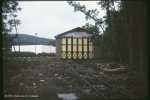 The Mount Union Engine House has
received some more paint since the spring, and the lead to the east
stall has been cleared of trees.
The Mount Union Engine House has
received some more paint since the spring, and the lead to the east
stall has been cleared of trees.
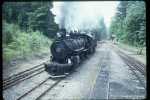 Upon drinking her fill, #14 heads north to rendezvous with her train for the day.
Upon drinking her fill, #14 heads north to rendezvous with her train for the day.
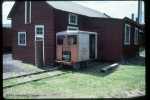 EBT's remaining Fairmont motor car comes out of the
Electrical Shop lean-to for some
needed maintenance on the drive belt.
EBT's remaining Fairmont motor car comes out of the
Electrical Shop lean-to for some
needed maintenance on the drive belt.
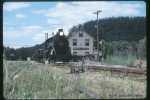 #14 departs Orbisonia Station with a trainload of passengers.
#14 departs Orbisonia Station with a trainload of passengers.
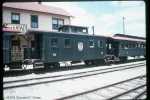 Caboose #28, always a favorite with kids of all ages, prepares for the
day's excursions. She has received rebuilt window panes.
Caboose #28, always a favorite with kids of all ages, prepares for the
day's excursions. She has received rebuilt window panes.
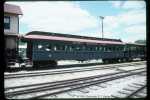 The last of the EBT's coaches, #8, continues to do the job for which
she was built.
The last of the EBT's coaches, #8, continues to do the job for which
she was built.
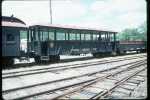 Boxcar #175, on the other hand, has taken a role that her designers
and builders surely could never have guessed.
Boxcar #175, on the other hand, has taken a role that her designers
and builders surely could never have guessed.
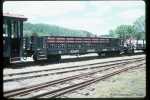 #119 is a bit more believable in the passenger hauling role, though any
EBT fan would wish to see more patrons making use of her new talent.
#119 is a bit more believable in the passenger hauling role, though any
EBT fan would wish to see more patrons making use of her new talent.
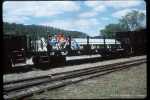 The basic black paint of #117 seems to have won her the fans of the
'cinder and smoke' experience for this trip.
The basic black paint of #117 seems to have won her the fans of the
'cinder and smoke' experience for this trip.
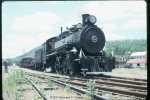 The second train of the season departs.
The second train of the season departs.
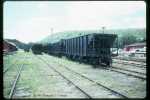 Basic black, again seems the vogue for hoppers. The ten operable hoppers
at the railroad received a fresh coat of black paint during the spring.
Most have yet to receive their white lettering.
Basic black, again seems the vogue for hoppers. The ten operable hoppers
at the railroad received a fresh coat of black paint during the spring.
Most have yet to receive their white lettering.
 Commencing the annual FEBT shops tour, EBT General Manager Stanley Hall
shares a laugh with the group.
Commencing the annual FEBT shops tour, EBT General Manager Stanley Hall
shares a laugh with the group.
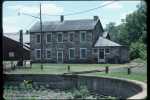 The Shops Office stands a constant
vigil over the yard.
The Shops Office stands a constant
vigil over the yard.
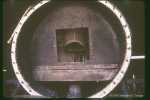 In the Roundhouse #17 gets her
yearly maintenance in preparation for the Fall Spectacular in October.
In the Roundhouse #17 gets her
yearly maintenance in preparation for the Fall Spectacular in October.
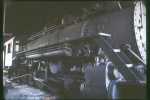 #16 stands ready should the call for her services come.
#16 stands ready should the call for her services come.
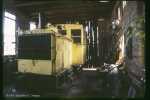 M-4 rests in the Paint Shop. She
currently does the day to day 'run about' jobs on the railroad.
M-4 rests in the Paint Shop. She
currently does the day to day 'run about' jobs on the railroad.
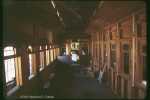 From the inside, the unfinished passenger car the 'Aughwick'. The car
is built on what was originally a D&RG flatcar and later an amusement
park open sided car.
From the inside, the unfinished passenger car the 'Aughwick'. The car
is built on what was originally a D&RG flatcar and later an amusement
park open sided car.
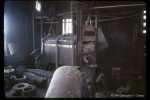 In the Blacksmith Shop this unit is a
small oven for the tempering of springs.
In the Blacksmith Shop this unit is a
small oven for the tempering of springs.
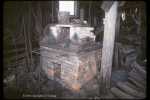 A forge in the Blacksmith Shop, this
one was used for high temperature work. The white brick around the top
are refractory material, like those made in the Mount Union refractory
plants. They act as a temperature resistant hood.
A forge in the Blacksmith Shop, this
one was used for high temperature work. The white brick around the top
are refractory material, like those made in the Mount Union refractory
plants. They act as a temperature resistant hood.
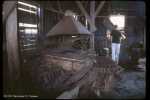 This one is a pretty standard blacksmith's forge. To the right of it
under all the locomotive grates is a quenching tub for use with the
forge.
This one is a pretty standard blacksmith's forge. To the right of it
under all the locomotive grates is a quenching tub for use with the
forge.
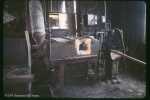 Here is the equipment used to place safe ends on locomotive flues.
At center is a forge specially designed for heating locomotive flues
for the welding and swaging process.
Here is the equipment used to place safe ends on locomotive flues.
At center is a forge specially designed for heating locomotive flues
for the welding and swaging process.
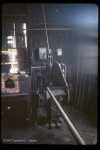 This small specialized hammer was used to join the flues and the
safe end (and extension piece of flue) together after they are joined
and heated. It is also used to swag the new end of the flue to fit
into the locomotive tube sheet.
This small specialized hammer was used to join the flues and the
safe end (and extension piece of flue) together after they are joined
and heated. It is also used to swag the new end of the flue to fit
into the locomotive tube sheet.
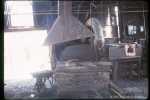 This is the standard coal fired blacksmith's forge, with the specialized
flue equipment at right.
This is the standard coal fired blacksmith's forge, with the specialized
flue equipment at right.
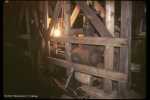 This rather underlit photo is the hydrostatic (hydraulic) pump
that supplied the shops. Like the main steam engine, it is covered
by the cribbing that supports the roof now.
This rather underlit photo is the hydrostatic (hydraulic) pump
that supplied the shops. Like the main steam engine, it is covered
by the cribbing that supports the roof now.
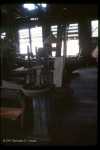 This is one of the many Grinders
in the shops.
This is one of the many Grinders
in the shops.
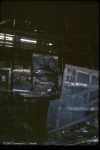 In the Car Shop one begins to see
more woodworking tools like this Band
Saw.
In the Car Shop one begins to see
more woodworking tools like this Band
Saw.
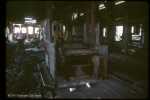 This is the larger Planer in the building.
This is the larger Planer in the building.
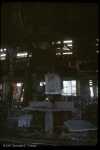 Here we see more woodworking tools with this
Chop Saw.
Here we see more woodworking tools with this
Chop Saw.
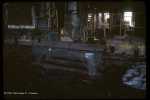 Here is the Table Saw, the third of four
saws in the building.
Here is the Table Saw, the third of four
saws in the building.
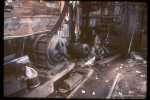 To the left of this photo is a large
electric motor that was likely added
after 1960 to operate the overhead lines in this building without the
use of the main steam engine.
To the right are the Motor and Pump
that supply water to the Reservoir Ponds
on the hillside southeast of the yard.
To the left of this photo is a large
electric motor that was likely added
after 1960 to operate the overhead lines in this building without the
use of the main steam engine.
To the right are the Motor and Pump
that supply water to the Reservoir Ponds
on the hillside southeast of the yard.
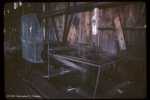 This is one of two Planers in
the Car Shop.
This is one of two Planers in
the Car Shop.
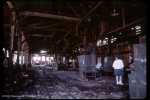 An overall look of the interior of the
Car Shop looking to the south.
An overall look of the interior of the
Car Shop looking to the south.
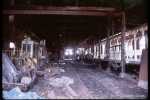 A motley crew of equipment is evident in this shot inside the
Car Shop looking north.
A motley crew of equipment is evident in this shot inside the
Car Shop looking north.
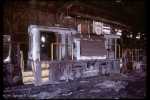 This Davenport cabless switcher apparently came from the US Steel
Clairton Works. It has never been observed turning a wheel at the EBT.
This Davenport cabless switcher apparently came from the US Steel
Clairton Works. It has never been observed turning a wheel at the EBT.
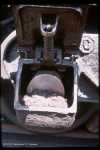 A closeup of the journal box interior on an EBT Hopper. The circular
part is the end of the axle, solidly fixed to the wheels. Above it
the gold wedge is the axle bearing, which rides on the machined
surface near the end of the axle. Above it is a wedge that transfers
the weight of the car from the journal box to the bearing.
A closeup of the journal box interior on an EBT Hopper. The circular
part is the end of the axle, solidly fixed to the wheels. Above it
the gold wedge is the axle bearing, which rides on the machined
surface near the end of the axle. Above it is a wedge that transfers
the weight of the car from the journal box to the bearing.
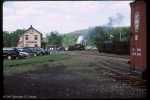 The last train of the day heads onto the wye to turn and unload.
The last train of the day heads onto the wye to turn and unload.
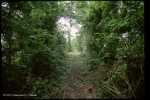 South of Adams Siding the
right-of-way has been cleared to the width of the track.
South of Adams Siding the
right-of-way has been cleared to the width of the track.
 The points of the south switch of
Adams Siding are visible here.
The points of the south switch of
Adams Siding are visible here.
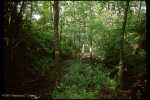 This cut is Morrisons Summit, the
first summit on the line.
This cut is Morrisons Summit, the
first summit on the line.
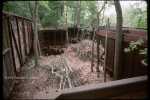 In Mount Union, five hoppers were purchased by the Cumbres and Toltec
in May. These are the locations of hopper 1054 (left) and an unknown
hopper (right).
In Mount Union, five hoppers were purchased by the Cumbres and Toltec
in May. These are the locations of hopper 1054 (left) and an unknown
hopper (right).
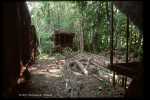 This is the former location of hopper 888. See the
News Article for the details.
This is the former location of hopper 888. See the
News Article for the details.
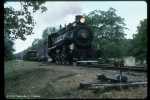 The second train on Sunday departs for the grove, about to cross
Rockhill Furnace Bridge.
The second train on Sunday departs for the grove, about to cross
Rockhill Furnace Bridge.
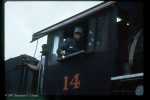 Tom Holder holds the reigns of #14 as she passes.
Tom Holder holds the reigns of #14 as she passes.
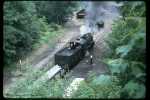 #14 turns the second train of the day and prepares to return to
the station to board for the third.
#14 turns the second train of the day and prepares to return to
the station to board for the third.
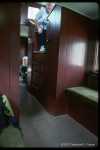 Aboard the third train, the interior of caboose #28 is a bit more
plush now than when trainmen rode in her.
Aboard the third train, the interior of caboose #28 is a bit more
plush now than when trainmen rode in her.
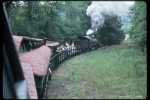 #14 breaks a sweat backing the train around the north leg of the
wye at the grove.
#14 breaks a sweat backing the train around the north leg of the
wye at the grove.
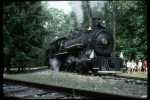 #14 poses at the grove for an admiring crowd.
#14 poses at the grove for an admiring crowd.
|
HOME |
The East Broad Top Railroad Homepage © 1994-2005 Christopher D. Coleman All rights reserved Site Information Top of this page |
|---|